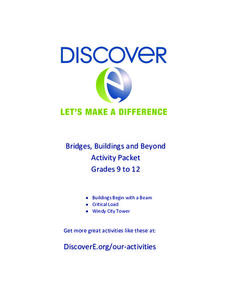DiscoverE
Bridges, Buildings and Beyond Activity Packet: Grades 9-12
Shore up engineering knowledge with some building activities. Scholars design a foam beam, create a structure from playing cards, and construct a paper tower that won't topple over in the wind. Along the way, they learn about engineering...
DiscoverE
Building Begins with a Beam
A sturdy beam made of foam seems like an oxymoron. Scholars design a 48-inch beam that can hold a one-pound weight. The beam should be sturdy enough so it doesn't bend too much. If it does, the egg placed underneath the beam will break.
Cornell University
Bridge Building
Bridge the gaps in your knowledge of bridges. Individuals learn about bridge types by building models. The activity introduces beam bridges, arch bridges, truss bridges, and suspension bridges.
Teach Engineering
Battle of the Beams
Make the strongest beam possible using taffy? Groups mold a taffy-water mixture into a beam and a reinforcing material of their choice. To finish the final installment of a two-part series, participants test its strength by adding...
Teach Engineering
Cost Comparisons
Our final proposal for the cost of the bridge requested is ... In the last segment in a series of 10, pairs work together to develop a proposal for a city bridge design. The class completes a cost comparison between concrete and steel to...
Teach Engineering
Load It Up!
See how a marshmallow can hold up a bridge load. Teams take a closer look at the design of bridge piers. They determine the types of loads that might affect a bridge, and, using that information, they calculate the needed cross-sectional...
Teach Engineering
Designing Bridges
Introduces your class to the types of loads experienced by a bridge. Groups calculate the ultimate load combinations to determine the maximum load requirement. Using this information, builders then determine the amount of material they...
Teach Engineering
Bridging the Gaps
The London Bridge should not have fallen down. And here's why. After a brief history of bridges and the three main types, class members are introduce to the concepts of tension and compression, the two main forces acting upon bridges.
Teach Engineering
Bridge Types: Tensile and Compressive Forces
Bridges rely on tension and compression to keep them standing. Pairs test this principle by constructing simple bridges and applying a force to the center. Teams use the provided worksheet to record their observations of the reaction of...
Curated OER
Dunkin` for Density
In this density worksheet, students complete a science lab experiment to determine the density that an object will float or sink in water. Students fill in a chart with their data, answer 4 short answer questions and write 1 conclusion...
Curated OER
Gymnastic Skills
Students use gymnastics beams, benches, mats, and wedges to practice gymnastics skills. For this gymnastics lesson plan, students practice balancing, tumbling, and jumping skills.
Curated OER
Quintaine Practice
In this Medieval history worksheet, students read an excerpt about quintaine and how it was created and used by a knight. They respond to three questions about jousting and how a squire became an expert using the quintaine. Finally,...
Curated OER
Engineering: Introduction to Legos
Students identify and examine various Lego building materials. They discover how to measure Lego blocks and cut out and paste pictures of the Legos on the Engineer's Parts List sheet.
Curated OER
Anasazi Pueblo Period: 700-1050 A.D.
Sixth graders investigate the main ideas and information about the Developmental Pueblo period, from 700-1050 A.D., of the Anasazi.
Cosmo Learning
Cosmo Learning: Mechanics of Solids
A collection of video lectures from a course introducing students to the mechanics of solids. Webpage includes forty-one lectures from a professor at the National Programme on Technology Enhanced Learning. Lectures vary in length and...
PBS
Pbs Teachers: Real Scientists: Earthquake Scientist
Learn how engineers use science to prevent buildings and bridges from collapsing during an earthquake.

















